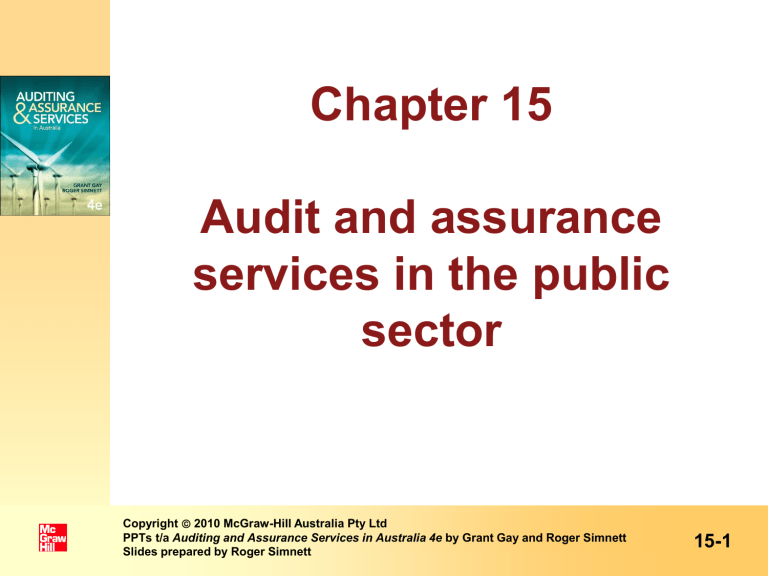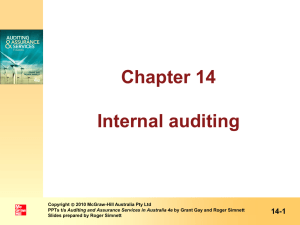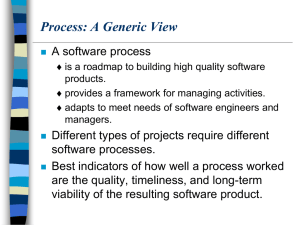Learning objective 1 - McGraw Hill Higher Education

Chapter 15
Audit and assurance services in the public sector
Copyright
2010 McGraw-Hill Australia Pty Ltd
PPTs t/a Auditing and Assurance Services in Australia 4e by Grant Gay and Roger Simnett
Slides prepared by Roger Simnett
15-1
Learning objective 1:
Australian system of government
• In a federal system such as Australia’s, the various functions of government are shared between the
Commonwealth, the states and territories, and local government bodies.
–
–
The Commonwealth Government covers matters of national importance such as defence and immigration.
State and territory government deal with social services such as education and public health.
– Local government authorities are concerned primarily with civic services and social services.
Copyright
2010 McGraw-Hill Australia Pty Ltd
PPTs t/a Auditing and Assurance Services in Australia 4e by Grant Gay and Roger Simnett
Slides prepared by Roger Simnett
15-2
Learning objective 2:
Accountability
•
• Parliament approves the use of various resources.
•
The management of public sector entities is entrusted with public resources on a stewardship basis.
• Reports are prepared showing the use of resources.
Public sector auditors provide assurance on these reports.
Copyright
2010 McGraw-Hill Australia Pty Ltd
PPTs t/a Auditing and Assurance Services in Australia 4e by Grant Gay and Roger Simnett
Slides prepared by Roger Simnett
15-3
Framework of accountability
Copyright
2010 McGraw-Hill Australia Pty Ltd
PPTs t/a Auditing and Assurance Services in Australia 4e by Grant Gay and Roger Simnett
Slides prepared by Roger Simnett
15-4
•
•
•
•
Sources of government revenue and expenditure
Governments derive their revenue from taxation, charging for goods and services, fines, sale of noncurrent assets and borrowing.
The Commonwealth also provides grants to the states and territories and to local government bodies.
Public expenditure involves public money being spent on providing goods and services to the public, and includes wages and salaries, rental charges, and the cost of assets consumed.
The control of public expenditure is one of the most important responsibilities of Parliament.
Copyright
2010 McGraw-Hill Australia Pty Ltd
PPTs t/a Auditing and Assurance Services in Australia 4e by Grant Gay and Roger Simnett
Slides prepared by Roger Simnett
15-5
Learning objective 3:
Government accounting
•
•
There is no Australia-wide legal reporting code for all public sector entities.
– Individual pieces of legislation have application only within their jurisdiction.
The Australian Accounting Standards require government departments that are reporting entities to prepare general-purpose financial reports using accrual accounting.
Copyright
2010 McGraw-Hill Australia Pty Ltd
PPTs t/a Auditing and Assurance Services in Australia 4e by Grant Gay and Roger Simnett
Slides prepared by Roger Simnett
15-6
Learning objective 4:
Public sector audit requirements
• Public sector auditors carry out their duties in accordance with an audit mandate, which specifies the type of audit to be conducted, the entity or activity to be audited and the powers and responsibilities of the auditor.
• Audit mandates are usually specified in legislation.
Copyright
2010 McGraw-Hill Australia Pty Ltd
PPTs t/a Auditing and Assurance Services in Australia 4e by Grant Gay and Roger Simnett
Slides prepared by Roger Simnett
15-7
International Developments
•
•
•
The movement towards a broad audit mandate is evident in international developments in public sector auditing.
There are commonly three elements of a governmental audit:
1.
2.
3.
Financial and compliance
Economy and efficiency
Program results.
Performance auditing has been also emphasised by the International Organization of Supreme Audit
Institutions (INTOSAI).
Copyright
2010 McGraw-Hill Australia Pty Ltd
PPTs t/a Auditing and Assurance Services in Australia 4e by Grant Gay and Roger Simnett
Slides prepared by Roger Simnett
15-8
Australian developments
•
•
Commonwealth Auditor-General, through Australian
National Audit Office (ANAO), is primarily responsible for the audit of Commonwealth government departments and statutory authorities and instrumentalities.
Each State and Territory has an Auditor-General, whose duties are governed by state/territory legislation and are similar to those of the
Commonwealth Auditor-General.
Copyright
2010 McGraw-Hill Australia Pty Ltd
PPTs t/a Auditing and Assurance Services in Australia 4e by Grant Gay and Roger Simnett
Slides prepared by Roger Simnett
15-9
Audit standards in the public sector
•
•
•
The Framework for Assurance Engagements,
(discussed in chapter 1) describes the framework within which the audit profession issues audit standards and audit guidance statements for services provided by external and internal auditors in the private and public sectors.
Public sector auditors in Australia perform audits in accordance with Australian auditing standards
These auditing standards should be applied to the extent that they are not inconsistent with or unnecessary to the public sector audit mandate.
Copyright
2010 McGraw-Hill Australia Pty Ltd
PPTs t/a Auditing and Assurance Services in Australia 4e by Grant Gay and Roger Simnett
Slides prepared by Roger Simnett
15-10
Reporting duties
• The audit report should state whether the financial report:
– Is prepared in accordance with Finance Minister’s orders
– Gives a true and fair view of the matters required by those orders.
• Requirements are virtually identical to Corporations
Act 2001 requirements.
Copyright
2010 McGraw-Hill Australia Pty Ltd
PPTs t/a Auditing and Assurance Services in Australia 4e by Grant Gay and Roger Simnett
Slides prepared by Roger Simnett
15-11
Additional reporting matters
•
•
•
•
•
•
Matters the Auditor-General may bring to the attention of
•
Parliament include:
Administrative operations of public sector
Significant breaches of legislation
Accounting and other records not properly maintained
Public money not correctly accounted for
Propriety and probity of transactions
Recommendations to improve administrative processes
Economy, efficiency and effectiveness of administration.
Copyright
2010 McGraw-Hill Australia Pty Ltd
PPTs t/a Auditing and Assurance Services in Australia 4e by Grant Gay and Roger Simnett
Slides prepared by Roger Simnett
15-12
Independence
•
•
•
The independence of an auditor is critical to the audit function.
The Auditor-General Act 1997 defines the powers, duties and responsibilities of the Commonwealth
Auditor-General, who is appointed by the Governor-
General following the approval of the Joint
Committee of Public Accounts and Audit for a period of 10 years.
The independence of the position is further protected by the requirement that the Auditor-General can be removed from office only if requested by both
Houses of Parliament in the same session.
Copyright
2010 McGraw-Hill Australia Pty Ltd
PPTs t/a Auditing and Assurance Services in Australia 4e by Grant Gay and Roger Simnett
Slides prepared by Roger Simnett
15-13
•
•
Learning objective 5:
Performance audits
The term ‘performance audit’ is usually applied in the public sector, with some application in the private sector.
– It has evolved with the broad objectives of reporting on economy, efficiency and effectiveness.
A performance audit is an independent, objective and systematic assessment of public sector entities’ programs, resources, information systems, performance measures, monitoring systems and legal and policy compliance (ANAO, 2009).
Copyright
2010 McGraw-Hill Australia Pty Ltd
PPTs t/a Auditing and Assurance Services in Australia 4e by Grant Gay and Roger Simnett
Slides prepared by Roger Simnett
15-14
Objectives of performance auditing
•
•
Objectives of performance auditing in the public sector are:
–
–
To provide parliament with assurance of the quality of management of public resources
To assist public sector managers by identifying, promoting and protecting better management practices.
A performance audit may include an audit of:
– Use of human, financial and other resources
–
–
Information systems, performance measures and monitoring arrangements
Procedures followed by audited bodies for remedying identified deficiencies.
Copyright
2010 McGraw-Hill Australia Pty Ltd
PPTs t/a Auditing and Assurance Services in Australia 4e by Grant Gay and Roger Simnett
Slides prepared by Roger Simnett
15-15
Performance audit direction
•
•
•
–
–
–
Performance audits are usually directed to a combination of the following three purposes:
Assessing performance
Identifying opportunities for improvement
Developing recommendations for improvement or further action.
In a particular performance audit engagement, one of these purposes may take precedence over the others.
This shows that the purpose of a performance audit is different to the purpose of a financial report audit.
Copyright
2010 McGraw-Hill Australia Pty Ltd
PPTs t/a Auditing and Assurance Services in Australia 4e by Grant Gay and Roger Simnett
Slides prepared by Roger Simnett
15-16
Economy defined
• Economy : acquisition of the appropriate quality and quantity of resources at the lowest cost.
(ASAE 3500.18).
• Examples of economy audits involve determining whether the entity has:
– followed sound procurement practices; and
– acquired the appropriate type, quality and amount of resources at the right time and for the lowest cost.
Copyright
2010 McGraw-Hill Australia Pty Ltd
PPTs t/a Auditing and Assurance Services in Australia 4e by Grant Gay and Roger Simnett
Slides prepared by Roger Simnett
15-17
Efficiency defined
• Efficiency: the use of resources such that output is maximised for any given set of inputs, or the use of minimum input resources for a given quantity and qualityof output. It is essentially a resource usage concept (ASAE 3500.18).
• Examples of efficiency audits involve determining whether the entity has:
– prevented idleness and overstaffing; and
– prevented duplication of effort by employees.
Copyright
2010 McGraw-Hill Australia Pty Ltd
PPTs t/a Auditing and Assurance Services in Australia 4e by Grant Gay and Roger Simnett
Slides prepared by Roger Simnett
15-18
Effectiveness defined
• Effectiveness : the achievement of the objectives or other intended effects of activities at a program or entity level. It focuses on the results or outcomes of the use of resources and of organisational operations (ASAE 3500.18).
• Examples of effectiveness audits include:
–
–
An audit of a program to determine whether it has achieved its objective(s), and
An analysis of the relevance of the entity’s activities to its objectives.
Copyright
2010 McGraw-Hill Australia Pty Ltd
PPTs t/a Auditing and Assurance Services in Australia 4e by Grant Gay and Roger Simnett
Slides prepared by Roger Simnett
15-19
Relationship between economy, efficiency and effectiveness
Copyright
2010 McGraw-Hill Australia Pty Ltd
PPTs t/a Auditing and Assurance Services in Australia 4e by Grant Gay and Roger Simnett
Slides prepared by Roger Simnett
15-20
Stages of a performance audit
1.
Planning stage
2.
Evidence gathering and analysis stage
3.
Reporting stage
4.
Follow-up
Copyright
2010 McGraw-Hill Australia Pty Ltd
PPTs t/a Auditing and Assurance Services in Australia 4e by Grant Gay and Roger Simnett
Slides prepared by Roger Simnett
15-21
The performance audit cycle
Copyright
2010 McGraw-Hill Australia Pty Ltd
PPTs t/a Auditing and Assurance Services in Australia 4e by Grant Gay and Roger Simnett
Slides prepared by Roger Simnett
15-22
Learning objective 6:
Regularity audits
•
•
The ANAO has indicated that regularity audits involve attestation of financial accountability of the
Commonwealth administration and Commonwealth entities.
Examples of regularity audits include:
– Financial report audits (already discussed)
– Compliance audits
Copyright
2010 McGraw-Hill Australia Pty Ltd
PPTs t/a Auditing and Assurance Services in Australia 4e by Grant Gay and Roger Simnett
Slides prepared by Roger Simnett
15-23
•
•
•
Compliance audits
Compliance engagements are another form of audit obligation that receives most attention in the public sector, although can be undertaken in the private sector.
ASAE 3100.11 defines a compliance engagement as being an assurance engagement where an auditor expresses a conclusion, after evaluating an entity’s compliance with the requirements as measured by the suitable criteria.
A compliance engagement may be either an audit or a review, and may be either an assertion based engagement or a direct reporting engagement.
Copyright
2010 McGraw-Hill Australia Pty Ltd
PPTs t/a Auditing and Assurance Services in Australia 4e by Grant Gay and Roger Simnett
Slides prepared by Roger Simnett
15-24
•
•
Compliance audits (cont.)
ASAE 3100 requires the auditor undertaking a compliance engagement to comply with the usual requirements with regard to ethics, quality control, acceptance, continuance, agreement on terms of the engagement and documentation, as would apply for any other assurance engagement.
Suitable criteria can be:
– Externally imposed criteria under law or directives, including legislation or regulation, or
– Internally imposed criteria as determined by management, including organisational policies and procedures.
Copyright
2010 McGraw-Hill Australia Pty Ltd
PPTs t/a Auditing and Assurance Services in Australia 4e by Grant Gay and Roger Simnett
Slides prepared by Roger Simnett
15-25




